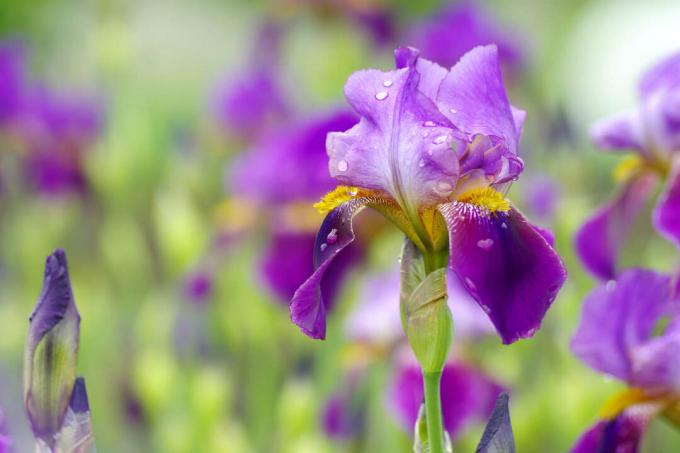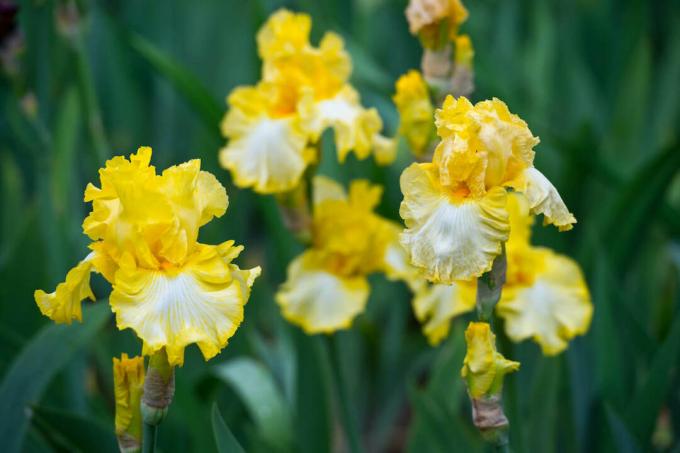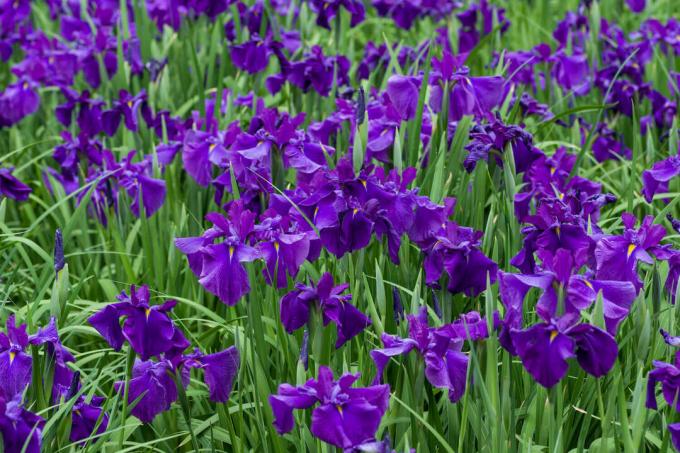Irises (also known as irises) are among the long-running favorites in German gardens. Everything you need to know about the flowering period, different varieties of the flower and caring for irises can be found in our overview.

A magnificent early summer perennial, the iris has long been a popular garden plant. There are countless iris species and cultivars, the flowers of which appear in many different colors and color combinations. Irises really do come in all the colors of the rainbow, as their name suggests. "Iris" comes from the Greek and means "rainbow".
contents
- Iris: flowering time, origin and properties
- Iris varieties: The most beautiful irises for the garden
-
Iris care: How to care for irises before and after flowering
- cut iris
- Fertilize iris
- watering iris
- Irises overwinter
- propagate irises
- Are irises poisonous?
Iris: flowering time, origin and properties
The irises (
iris) form a genus of plants in the iris family (Iridaceae) and have been at home in our gardens for centuries. Even if their name suggests otherwise, irises are only distantly related to lilies. The many iris species are distributed in the temperate zone of the northern hemisphere. The bearded iris (Iris barbata). Three groups can be distinguished according to size and flowering time. The lower a strain grows, the sooner it will flower. The Barbata Elatior group consists of large irises with a height of 60 to 120 centimeters and a flowering period from late May to June. Not only does it have the longest flower stalks, it also has the largest flowers. Slightly earlier in May, irises of the medium-tall Barbata Intermedia or Barbata Media group bloom, the stems of which grow to 40 to 60 centimeters in height. The small irises of the Barbata Nana group, which are at most 40 centimeters high, bloom as early as mid-April and are therefore a herald of spring. They are ideal for rock gardens and borders.Less known, but at least as elegant is the steppe iris (Iris spuria). It grows up to 150 centimeters high and combines well with the slightly smaller meadow iris (Iris sibirica) combine. With a flowering period from February to March, the dwarf iris species belong Iris reticulata and Iris danfordiae to the earliest Iris species. The Japanese swamp iris (Iris ensata) adorns the edges of ponds in various colors from pink to blue to violet and grows to a height of 80 to 100 centimetres.
The iris flowers are composed of 3 inner and outer petals. The inner leaves of the bearded iris are folded upwards and closed. They form the "dome" that appears less developed and lower in other Iris species. The 3 outer leaves hang sideways. In the case of the beard iris, the upper part of the outer leaves is also provided with a brush-like structure, the eponymous "beard".

All of the iris species mentioned have narrow, sword-shaped and upright leaves. They are mostly bright green to gray-green in color and sometimes have a slightly bluish tinge. Depending on the species, irises have tubers, rhizomes or bulbs as storage organs.
Iris varieties: The most beautiful irises for the garden
The species mentioned above each cover a large range of varieties. These are the most beautiful irises for the garden:
Tall Beard Iris (iris Barbata Elatior Group)
- 'Kupferhammer': Robust and floriferous variety from 1930; yellow dome, mahogany red drop leaves, marbled in the middle, beard in orange; Height: 40cm; Flowering period: May - June.
- ′Provencal′: burgundy red, leaves with a yellow center; Height: 85cm; Flowering period: May - June.
- ′Proud Tradition′: Delicate violet dome, strong violet-blue falls; Height: 100cm; Flowering time: May.
Medium beard iris (iris Barbata Intermedia or iris Barbata Media Group)
- ′Arctic Fancy′: White, slightly marbled ground with a violet edge; Height: 50cm; Flowering period: May - June.
- ′Swizzle′: golden yellow flowers; Height: 50-70cm; Flowering period: May - June.
- ′Con Brio′: dark purple drop leaves, light purple dome; flowers are fragrant; Height: 60cm; Flowering period: May and September.
Low Beard Iris (iris Barbata Nana group)
- 'Little Buccaneer': Maroon-red flowers, yellow beard; Height: 25cm; Flowering time: April - May.
- ′Church Stoke′: violet dome, violet falls (color deepens slightly towards the middle), yellow-white beard; fragrant; Height: 25cm; Flowering time: April - May.
- ′Soft Air′: White-yellow flowers; Height: 30cm; Flowering time: April - May.

steppe iris (Iris spuria)
- ′Betty Cooper′: petals lemon yellow in the center with fine lavender lines surrounded by a soft purple border; Height: 120cm; Flowering period: May - June.
- ′Archie Owen′: Brilliant golden yellow flowers; Height: 90-100cm; Flowering time: June.
meadow iris (Iris sibirica)
- ′Butter and Sugar′: standards sugar-yellow, hanging leaves butter-yellow; Height: 40-60cm; Flowering period: May - June.
- 'Caesar's Brother': Small dark purple flowers; Height: 60-100cm; Flowering period: May - June.
dwarf iris
- Iris reticulata ′Harmony′: Small net-leaf iris with delicate, cornflower-blue petals, mottled yellow-white toward the center; Height: 10-15cm; Flowering period: February - March.
- Iris histrioides ′Katharine Hodgkin′: petals with light blue veins on white ground, yellow zone towards the center with dark blue spots; Height: 15-25cm; Flowering time: March - April.
Japanese swamp iris (Iris ensata)
- 'Galathea': standards are rather short and dainty, drop leaves are very wide and often have pretty veins; white-purple flower; Height: 80cm; Flowering period: June - July.

Iris care: How to care for irises before and after flowering
You can find out how to plant irises correctly and which location is best for which species in our special article on the subject plant irises. Below are some tips for pruning and fertilizing the iris. Tall varieties in particular should also be supported during the flowering period.
cut iris
The iris flowers should be cut off after flowering for a number of reasons. On the one hand, this avoids the energy-intensive formation of seeds, and on the other hand, fungi and diseases are prevented. Cut back faded irises to about 10 centimeters. The leaves can be left standing, they are also a decorative element in the perennial border in winter. If fungi appear, the leaflets are also cut back and the plants put out new leaves in midsummer. Some iris varieties, such as the high bearded iris 'Total Recall' or 'English Cottage', react to a consistent pruning after the first flowering with a second flowering phase in autumn.
Fertilize iris
Modern iris varieties need more nutrients than older varieties. You should fertilize the iris at least once a year. The right time for fertilization is in March, when the perennials start to sprout. A second fertilization can be done in May. It is best to choose a fertilizer with a high potash content, such as ours Plantura organic flower fertilizer with long-term effect. This covers the nutrient requirements of your irises in the long term and supports their development into healthy and resilient plants.
watering iris
Young iris flowers should be watered from time to time. Older plants that have established themselves well in their location usually do not need to be watered. If the drought lasts for a long time, however, they should be supplied with a little water to be on the safe side.
Irises overwinter
Most iris species are hardy and can survive the winter months without additional protection in the garden. However, some species, such as the meadow iris, are more sensitive to cold and should be prepared for the winter. Cut the flower stalks about 10 centimeters above the rhizome and remove discolored leaves and dried leaf tips. In autumn, cover the irises with a layer of leaves, twigs or straw so that they are not unprotected from the effects of frost.
propagate irises
One way to propagate irises is by dividing the rhizomes in spring or after flowering. Even if you do not necessarily want to multiply the irises in your garden, this measure is advisable. The flowering strength of the iris often decreases after 3 to 5 years. By dividing the rhizomes, the perennials are naturally stimulated to form new iris flowers.
Divide irises: step-by-step instructions
- When: late summer.
- Carefully dig the rhizomes out of the ground.
- Cut through the rhizomes with a sharp knife at the recognizable constrictions (the cut surface should be as small as possible).
- Crop the leaves by about half (this will reduce evaporation and avoid weakening the plants).
- Select the young, vital rootstocks (the edge pieces are the strongest) and plant out fist-sized pieces again.
- Pour vigorously.

As an alternative to dividing the roots, which produces pure irises, irises can also be propagated by sowing. Wait until the capsule fruits are ripe and then harvest the seeds. Irises are cold and dark germs. Therefore, put the seeds in the refrigerator a few days before sowing. Then they can be sown in a sheltered place in pots filled with substrate and covered with a layer of soil about 2 centimeters high. Our peat-free, for example, is a suitable substrate Plantura Organic Herb & Seed Soil optimal. With continuous humidification and a temperature of around 15 °C, the iris seeds germinate and develop into new plants.
Are irises poisonous?
All parts of the plant, but especially the roots of the iris, contain toxic substances that cause serious symptoms of poisoning if consumed. In some cases, they can also lead to skin irritation or even dermatitis when touched. Therefore, for safety, the iris should be planted in a place inaccessible to children and pets.
If you Plant irises in your garden you will find helpful tips in our special article on planting irises.
In our article about hardy perennials you can also gather further inspiration for your perennial garden.



